广东省河源市正德中学九年级英语全册写作教程课件:Unit 10 (共31张PPT)
文档属性
| 名称 | 广东省河源市正德中学九年级英语全册写作教程课件:Unit 10 (共31张PPT) |  | |
| 格式 | zip | ||
| 文件大小 | 1.2MB | ||
| 资源类型 | 教案 | ||
| 版本资源 | 人教新目标(Go for it)版 | ||
| 科目 | 英语 | ||
| 更新时间 | 2017-09-27 21:59:51 | ||
图片预览

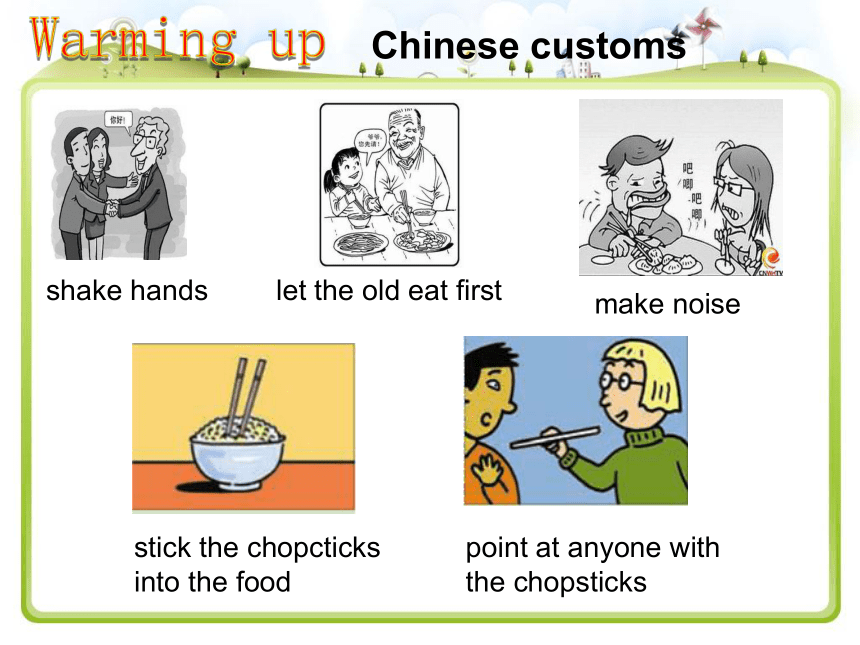

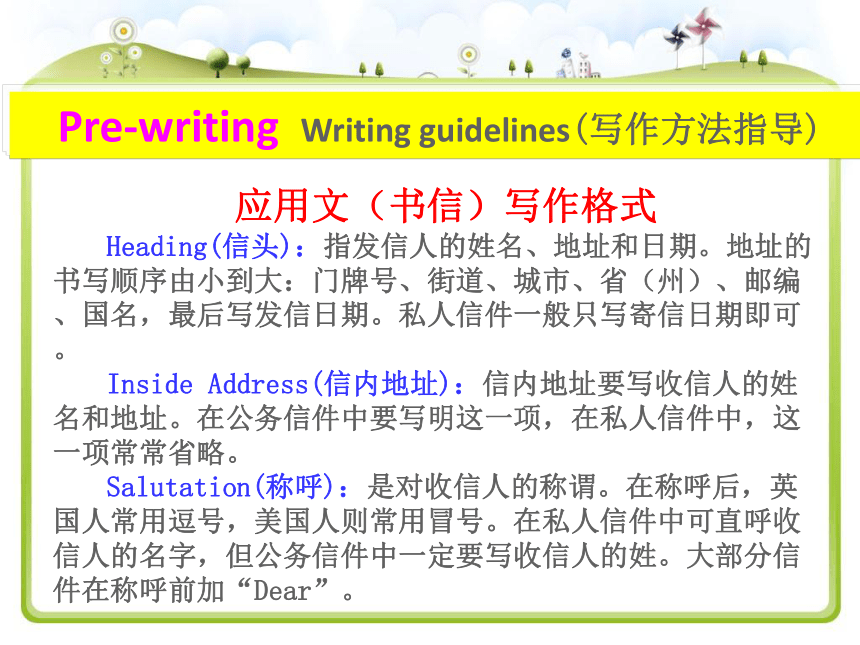
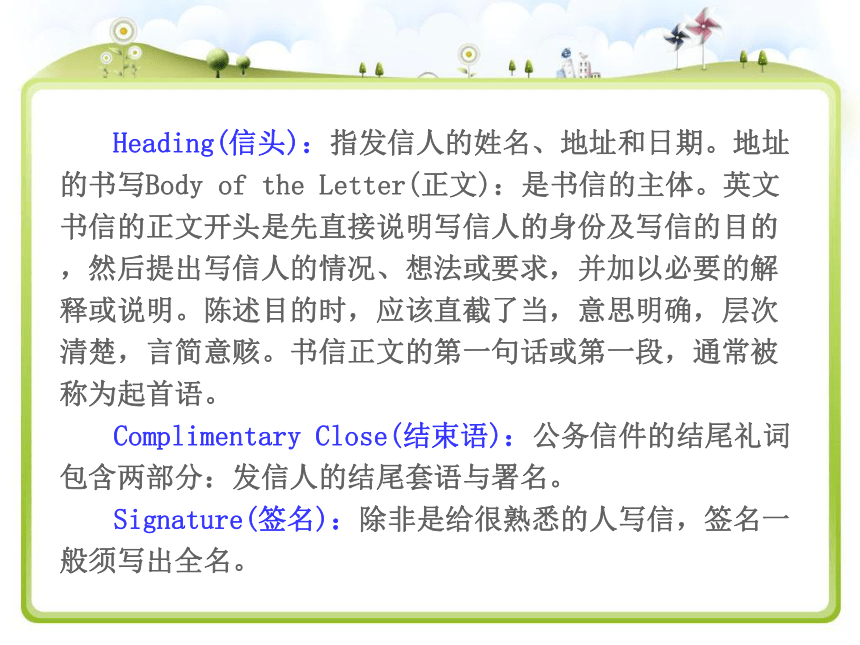
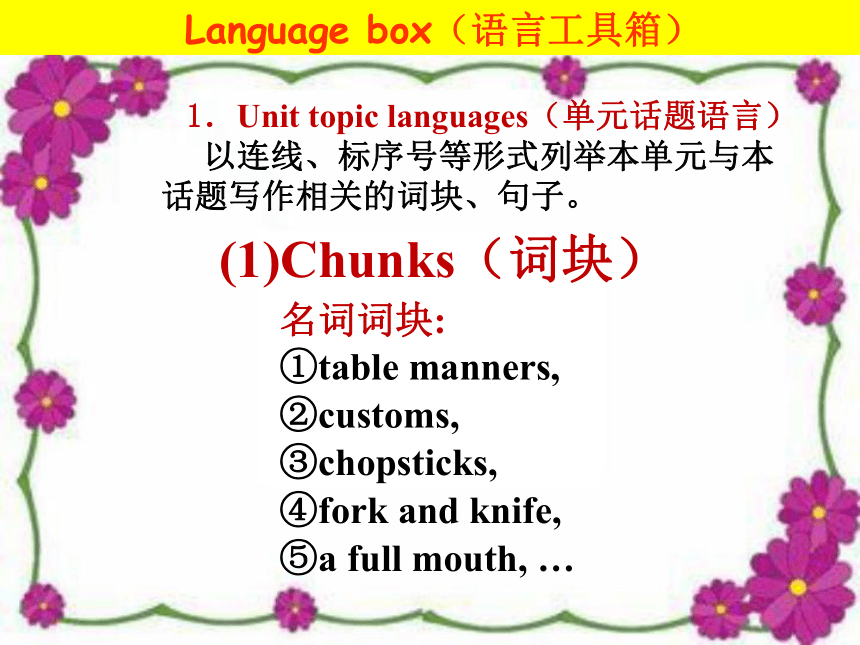

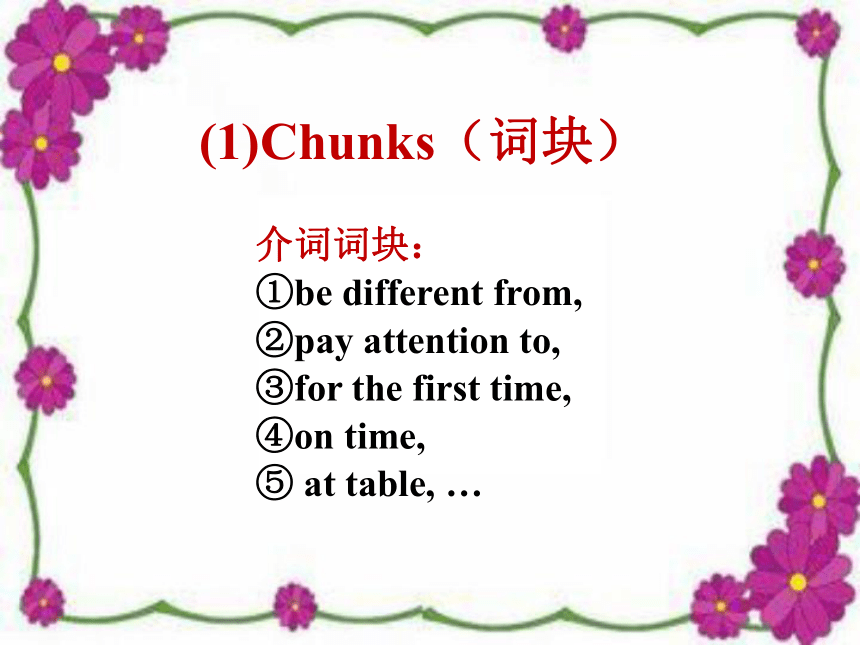

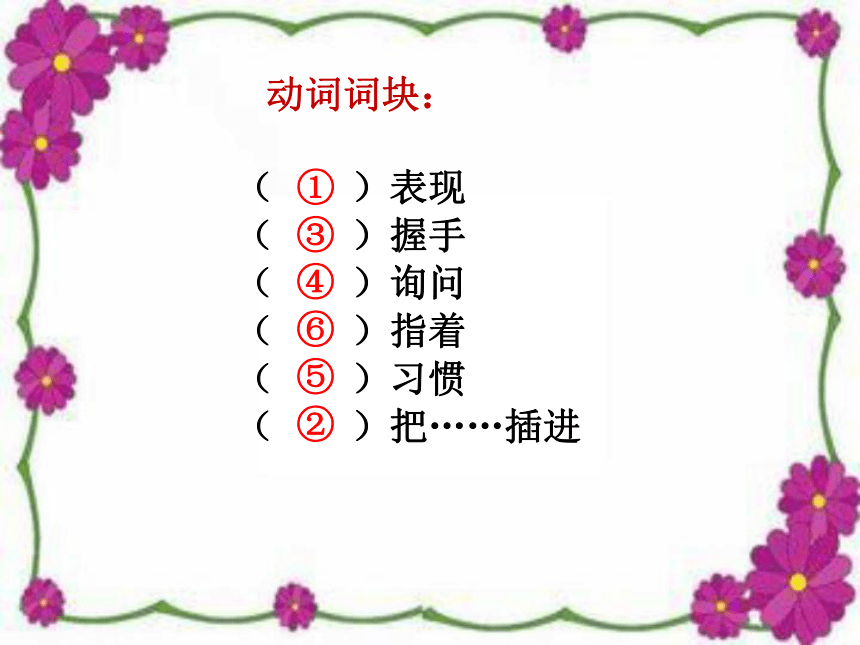
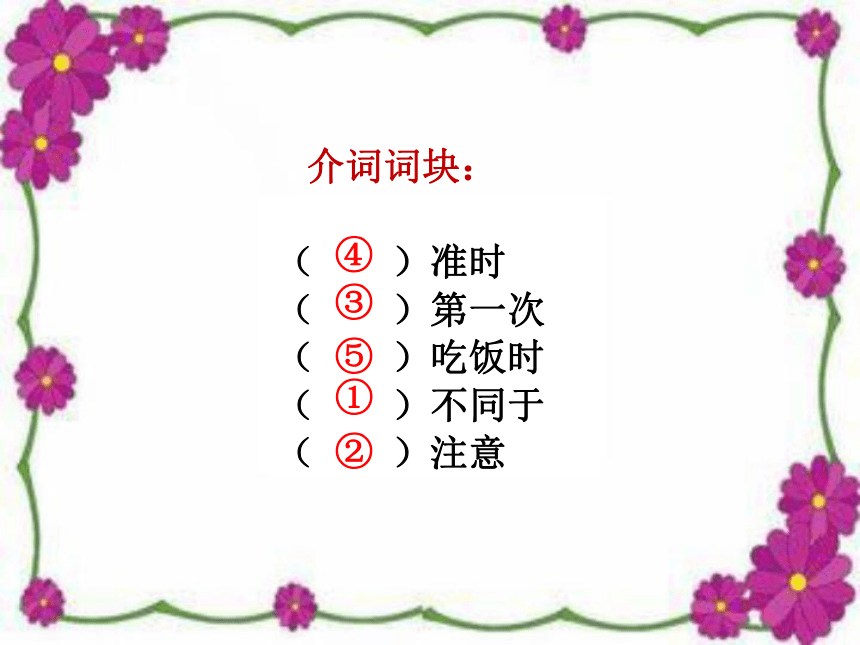
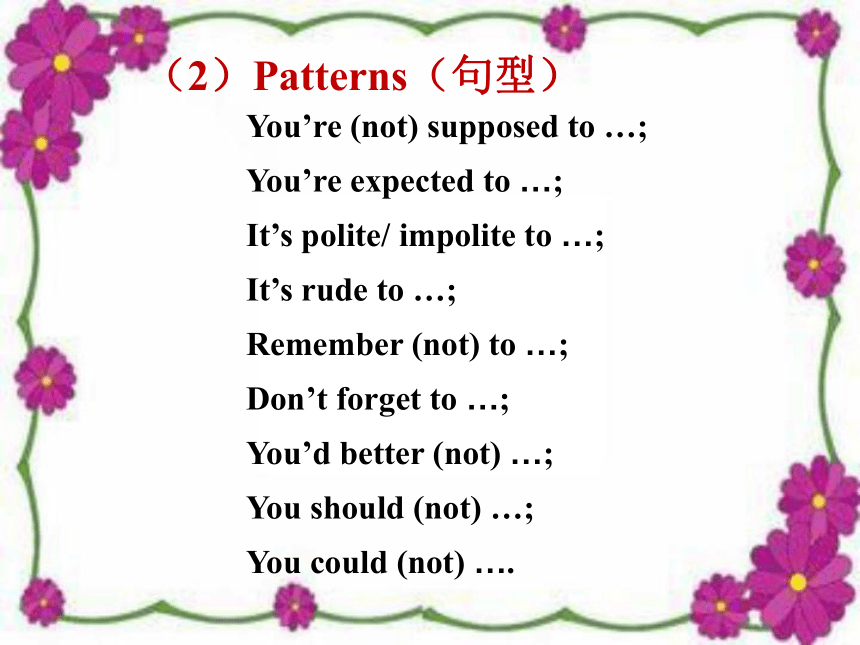
文档简介
课件31张PPT。Unit 10
Customs in China写作话题 : Language and culture (语言与文化)Warming up Chinese customsshake hands let the old eat first make noise stick the chopcticks into the foodpoint at anyone with the chopsticks1. 能运用本单元的重点句型be supposed to do sth,be expected to do sth.,it’s + adj. + for sb. + to do sth. 来描述见面、进餐和与人外出等礼仪。
2. 懂得按照“主题句—细节句”展开段落写作。
3. 了解各国文化背景、礼仪习俗,学会在不同场合的得体表现,提升跨文化意识。Learning objectives:Pre-writing Writing guidelines(写作方法指导)应用文(书信)写作格式
Heading(信头):指发信人的姓名、地址和日期。地址的书写顺序由小到大:门牌号、街道、城市、省(州)、邮编、国名,最后写发信日期。私人信件一般只写寄信日期即可。
Inside Address(信内地址):信内地址要写收信人的姓名和地址。在公务信件中要写明这一项,在私人信件中,这一项常常省略。
Salutation(称呼):是对收信人的称谓。在称呼后,英国人常用逗号,美国人则常用冒号。在私人信件中可直呼收信人的名字,但公务信件中一定要写收信人的姓。大部分信件在称呼前加“Dear”。 Heading(信头):指发信人的姓名、地址和日期。地址的书写Body of the Letter(正文):是书信的主体。英文书信的正文开头是先直接说明写信人的身份及写信的目的,然后提出写信人的情况、想法或要求,并加以必要的解释或说明。陈述目的时,应该直截了当,意思明确,层次清楚,言简意赅。书信正文的第一句话或第一段,通常被称为起首语。
Complimentary Close(结束语):公务信件的结尾礼词包含两部分:发信人的结尾套语与署名。
Signature(签名):除非是给很熟悉的人写信,签名一般须写出全名。1.Unit topic languages(单元话题语言)
以连线、标序号等形式列举本单元与本话题写作相关的词块、句子。Language box(语言工具箱)名词词块:
①table manners,
②customs,
③chopsticks,
④fork and knife,
⑤a full mouth, …(1)Chunks(词块)动词词块:
①behave,
②stick … into …,
③shake hands,
④ask about,
⑤get used to,
⑥point at,…(1)Chunks(词块)介词词块:
①be different from,
②pay attention to,
③for the first time,
④on time,
⑤ at table, …(1)Chunks(词块)Quiz: Read aloud the chunks above and try to match the meaning by numbering.名词词块:
( )习俗,
( )筷子
( )刀叉
( )餐桌礼仪
( )嘴巴塞得满满的①②③④⑤动词词块:
( )表现
( )握手
( )询问
( )指着
( )习惯
( )把……插进③④⑤①⑥②介词词块:
( )准时
( )第一次
( )吃饭时
( )不同于
( )注意③④⑤①②(2)Patterns(句型)You’re (not) supposed to …;
You’re expected to …;
It’s polite/ impolite to …;
It’s rude to …;
Remember (not) to …;
Don’t forget to …;
You’d better (not) …;
You should (not) …;
You could (not) ….2. Extensive languages(拓展性语言)Famous saying,proverbs, aphorisms and Classical sample sentences(名言、谚语、警句与经典例句)(1)When in Rome, do as Romans do.
入乡随俗。?
(2) "After you" is good manners.????
“您先请”是礼貌。
(3) Custom is the guide of the ignorant.????
习俗是无知者的向导。
(4) Custom makes all things easy.????
若照习俗办,万事皆不难。Making sentencesComplete the sentences according to the situations.① When you meet people for the first time in China, you ______________________.
② If there are older people at the table, you _____________________________. Instead , you ____________________.
③ It ___________________________________
while you are eating with chopsticks.
④ You ________________________________ , either.
⑤ You __________________________ when you are eating dinner.
are supposed to shake handsshould let the old eat firstare not supposed to start eating firstis impolite to stick your chopsticks into your foodshouldn't point at anyone with your chopsticksare not supposed to make any noise Reading for the writing structure阅读Section B 2b 文本的第二个段落,提取段落的框架主题句:
细节句:
结尾句:
a.
b.
c.
d.
My biggest challenge is learning how to behave at the dinner table.
For example, you’re not supposed to put …. Another example is that you’re not supposed to eat …. Another thing is that it is impolite to say ….Also, you’re not supposed to put…I have to say that I find it difficult to remember everything but I’m gradually ….While writing 你的法国笔友Mark将要到中国来学习交流。他想向你了解一些中国习俗。请你写一封信告诉他在中国如何表现得体。
内容提示:
1.见面礼仪;
2.餐桌礼仪;
3.参加派对礼仪。
要求:
1.必须包括以上的内容提示,可适当发挥;
2.语句连贯,词数80个左右。开头和结尾已给出,不计入总词数。
Dear Mark,
I’m glad to hear that you are coming to China soon. Let me give you some advice about customs in China.
____________________________________________________
______________________________________________________
Have a good trip, and I look forward to meeting you soon!
Best wishes.
Yours,
_________Writing TaskStep 1 Think and Fill(想一想,填一填)审题
体裁:__________________
人称:__________________
时态:__________________第二人称 一般现在时应用文BeginningEndingStep 2 Read and Fill.(读一读,填一填)BodyDear Mark,
I’m glad to hear that you are coming to China soon. Let me give you some advice about customs in China.
___________________________________________
_________________________________________________________________________________________________________________________________
Have a good trip, and I look forward to meeting you soon!
Best wishes.
Yours,
_________Writing TimeStep 3 Write(写一写)用词方面: 代词主格,宾格; 名词单复数;
动词搭配;副词位置 句子方面: 篇章方面: 细节方面: 句子完整;主谓一致;动词时态;
连词使用内容完整;要点齐全;布局合理 单词拼写;标点符号;大小写 Step 4 Check(查一查)Appreciating & Evaluating 欣赏与评价After writing:①请交换习作互相欣赏,用红笔划出对方的亮点,并对 不足的地方进行适当修改。
②你能给同学什么建议,使得对方的习作更好呢?
③根据worksheet上的评分标准,给同伴的习作打分。
请和同伴交换习作,依据以上提示和下列评价表,相互欣赏与修改习作,然后给对方的习作打分。Step 5 同伴互赏—我欣赏,我快乐!修改习作时可使用这些符号:
优美句子 ~; 漏词 ∧;
错处 ○; 删除 /;
语法错误 G ; 人称错误 P;
时态错误 T; 拼写错误 Sp。 评 分 表乐在分享
乐在交流Show TimeDear Mark,
You must be excited about coming to China soon. Let me give you some advice about customs in China.
In China, when you meet people for the first time, you are supposed to shake hands. While eating, you should eat with chopsticks instead of forks and knives. It’s impolite to talk with a full mouth. If you go to a party, don’t forget to be on time. Although things here are quite different from the way they are in your country, I believe you’ll get used to them.
Have a good trip, and I look forward to meeting you soon!
Best wishes.
Yours,
Coco文笔流畅,表达准确。语言简洁精炼。用了should, be supposed to, Don’t forget to, It’s impolite to不同的句式,使文章语言丰富。用了数个连词,结构紧凑,衔接自然连贯。道出中国还有很多风俗与法国的截然不同,话锋一转,作出积极鼓励,让外国友人有信心能适应我们国家的风俗。Dear Mark,
You must be excited about coming to China soon. Let me give you some advice about customs in China.
You’re expected to shake hands or say “Hello” when you meet someone. It’s important for you to learn how to behave at the dinner table. Remember not to stick your chopsticks into your food. Also, it’s rude to play with your chopsticks, such as pointing at the others, or hitting an empty bowl and so on. You’d better take a gift when you go for a party. When in Rome, do as Romans do.
Have a good trip, and I look forward to meeting you soon!
Best wishes.
Yours,
Coco点面结合,举例丰富、具体,使文章生动,详略得当,令读者一目了然。长短句结合,用词恰当,语言生动活泼,可读性强。引用谚语,点明文章主旨,起到画龙点睛的作用。连词的使用使得行文连贯,层次分明。SUmmary1. 我们是否懂得按照“主题句—细节句”展开段落写作;2. 写作时是否做到学以致用,运用阅读文本中所学的句型灵活进行表达;3. 评价同伴的习作时有没有先从整体上审视全文,从他人的习作中吸取写作的优点。When in Rome, do as Romans do. Rewrite your article.Homework
Customs in China写作话题 : Language and culture (语言与文化)Warming up Chinese customsshake hands let the old eat first make noise stick the chopcticks into the foodpoint at anyone with the chopsticks1. 能运用本单元的重点句型be supposed to do sth,be expected to do sth.,it’s + adj. + for sb. + to do sth. 来描述见面、进餐和与人外出等礼仪。
2. 懂得按照“主题句—细节句”展开段落写作。
3. 了解各国文化背景、礼仪习俗,学会在不同场合的得体表现,提升跨文化意识。Learning objectives:Pre-writing Writing guidelines(写作方法指导)应用文(书信)写作格式
Heading(信头):指发信人的姓名、地址和日期。地址的书写顺序由小到大:门牌号、街道、城市、省(州)、邮编、国名,最后写发信日期。私人信件一般只写寄信日期即可。
Inside Address(信内地址):信内地址要写收信人的姓名和地址。在公务信件中要写明这一项,在私人信件中,这一项常常省略。
Salutation(称呼):是对收信人的称谓。在称呼后,英国人常用逗号,美国人则常用冒号。在私人信件中可直呼收信人的名字,但公务信件中一定要写收信人的姓。大部分信件在称呼前加“Dear”。 Heading(信头):指发信人的姓名、地址和日期。地址的书写Body of the Letter(正文):是书信的主体。英文书信的正文开头是先直接说明写信人的身份及写信的目的,然后提出写信人的情况、想法或要求,并加以必要的解释或说明。陈述目的时,应该直截了当,意思明确,层次清楚,言简意赅。书信正文的第一句话或第一段,通常被称为起首语。
Complimentary Close(结束语):公务信件的结尾礼词包含两部分:发信人的结尾套语与署名。
Signature(签名):除非是给很熟悉的人写信,签名一般须写出全名。1.Unit topic languages(单元话题语言)
以连线、标序号等形式列举本单元与本话题写作相关的词块、句子。Language box(语言工具箱)名词词块:
①table manners,
②customs,
③chopsticks,
④fork and knife,
⑤a full mouth, …(1)Chunks(词块)动词词块:
①behave,
②stick … into …,
③shake hands,
④ask about,
⑤get used to,
⑥point at,…(1)Chunks(词块)介词词块:
①be different from,
②pay attention to,
③for the first time,
④on time,
⑤ at table, …(1)Chunks(词块)Quiz: Read aloud the chunks above and try to match the meaning by numbering.名词词块:
( )习俗,
( )筷子
( )刀叉
( )餐桌礼仪
( )嘴巴塞得满满的①②③④⑤动词词块:
( )表现
( )握手
( )询问
( )指着
( )习惯
( )把……插进③④⑤①⑥②介词词块:
( )准时
( )第一次
( )吃饭时
( )不同于
( )注意③④⑤①②(2)Patterns(句型)You’re (not) supposed to …;
You’re expected to …;
It’s polite/ impolite to …;
It’s rude to …;
Remember (not) to …;
Don’t forget to …;
You’d better (not) …;
You should (not) …;
You could (not) ….2. Extensive languages(拓展性语言)Famous saying,proverbs, aphorisms and Classical sample sentences(名言、谚语、警句与经典例句)(1)When in Rome, do as Romans do.
入乡随俗。?
(2) "After you" is good manners.????
“您先请”是礼貌。
(3) Custom is the guide of the ignorant.????
习俗是无知者的向导。
(4) Custom makes all things easy.????
若照习俗办,万事皆不难。Making sentencesComplete the sentences according to the situations.① When you meet people for the first time in China, you ______________________.
② If there are older people at the table, you _____________________________. Instead , you ____________________.
③ It ___________________________________
while you are eating with chopsticks.
④ You ________________________________ , either.
⑤ You __________________________ when you are eating dinner.
are supposed to shake handsshould let the old eat firstare not supposed to start eating firstis impolite to stick your chopsticks into your foodshouldn't point at anyone with your chopsticksare not supposed to make any noise Reading for the writing structure阅读Section B 2b 文本的第二个段落,提取段落的框架主题句:
细节句:
结尾句:
a.
b.
c.
d.
My biggest challenge is learning how to behave at the dinner table.
For example, you’re not supposed to put …. Another example is that you’re not supposed to eat …. Another thing is that it is impolite to say ….Also, you’re not supposed to put…I have to say that I find it difficult to remember everything but I’m gradually ….While writing 你的法国笔友Mark将要到中国来学习交流。他想向你了解一些中国习俗。请你写一封信告诉他在中国如何表现得体。
内容提示:
1.见面礼仪;
2.餐桌礼仪;
3.参加派对礼仪。
要求:
1.必须包括以上的内容提示,可适当发挥;
2.语句连贯,词数80个左右。开头和结尾已给出,不计入总词数。
Dear Mark,
I’m glad to hear that you are coming to China soon. Let me give you some advice about customs in China.
____________________________________________________
______________________________________________________
Have a good trip, and I look forward to meeting you soon!
Best wishes.
Yours,
_________Writing TaskStep 1 Think and Fill(想一想,填一填)审题
体裁:__________________
人称:__________________
时态:__________________第二人称 一般现在时应用文BeginningEndingStep 2 Read and Fill.(读一读,填一填)BodyDear Mark,
I’m glad to hear that you are coming to China soon. Let me give you some advice about customs in China.
___________________________________________
_________________________________________________________________________________________________________________________________
Have a good trip, and I look forward to meeting you soon!
Best wishes.
Yours,
_________Writing TimeStep 3 Write(写一写)用词方面: 代词主格,宾格; 名词单复数;
动词搭配;副词位置 句子方面: 篇章方面: 细节方面: 句子完整;主谓一致;动词时态;
连词使用内容完整;要点齐全;布局合理 单词拼写;标点符号;大小写 Step 4 Check(查一查)Appreciating & Evaluating 欣赏与评价After writing:①请交换习作互相欣赏,用红笔划出对方的亮点,并对 不足的地方进行适当修改。
②你能给同学什么建议,使得对方的习作更好呢?
③根据worksheet上的评分标准,给同伴的习作打分。
请和同伴交换习作,依据以上提示和下列评价表,相互欣赏与修改习作,然后给对方的习作打分。Step 5 同伴互赏—我欣赏,我快乐!修改习作时可使用这些符号:
优美句子 ~; 漏词 ∧;
错处 ○; 删除 /;
语法错误 G ; 人称错误 P;
时态错误 T; 拼写错误 Sp。 评 分 表乐在分享
乐在交流Show TimeDear Mark,
You must be excited about coming to China soon. Let me give you some advice about customs in China.
In China, when you meet people for the first time, you are supposed to shake hands. While eating, you should eat with chopsticks instead of forks and knives. It’s impolite to talk with a full mouth. If you go to a party, don’t forget to be on time. Although things here are quite different from the way they are in your country, I believe you’ll get used to them.
Have a good trip, and I look forward to meeting you soon!
Best wishes.
Yours,
Coco文笔流畅,表达准确。语言简洁精炼。用了should, be supposed to, Don’t forget to, It’s impolite to不同的句式,使文章语言丰富。用了数个连词,结构紧凑,衔接自然连贯。道出中国还有很多风俗与法国的截然不同,话锋一转,作出积极鼓励,让外国友人有信心能适应我们国家的风俗。Dear Mark,
You must be excited about coming to China soon. Let me give you some advice about customs in China.
You’re expected to shake hands or say “Hello” when you meet someone. It’s important for you to learn how to behave at the dinner table. Remember not to stick your chopsticks into your food. Also, it’s rude to play with your chopsticks, such as pointing at the others, or hitting an empty bowl and so on. You’d better take a gift when you go for a party. When in Rome, do as Romans do.
Have a good trip, and I look forward to meeting you soon!
Best wishes.
Yours,
Coco点面结合,举例丰富、具体,使文章生动,详略得当,令读者一目了然。长短句结合,用词恰当,语言生动活泼,可读性强。引用谚语,点明文章主旨,起到画龙点睛的作用。连词的使用使得行文连贯,层次分明。SUmmary1. 我们是否懂得按照“主题句—细节句”展开段落写作;2. 写作时是否做到学以致用,运用阅读文本中所学的句型灵活进行表达;3. 评价同伴的习作时有没有先从整体上审视全文,从他人的习作中吸取写作的优点。When in Rome, do as Romans do. Rewrite your article.Homework
同课章节目录
- Unit 1 How can we become good learners.
- Section A
- Section B
- Unit 2 I think that mooncakes are delicious!
- Section A
- Section B
- Unit 3 Could you please tell me where the restroom
- Section A
- Section B
- Unit 4 I used to be afraid of the dark.
- Section A
- Section B
- Unit 5 What are the shirts made of?
- Section A
- Section B
- Review of Units 1-5
- Unit 6 When was it invented?
- Section A
- Section B
- Unit 7 Teenagers should be allowed to choose their
- Section A
- Section B
- Unit 8 It must belong to Carla.
- Section A
- Section B
- Unit 9 I like music that I can dance to.
- Section A
- Section B
- Unit 10 You're supposed to shake hands.
- Section A
- Section B
- Review of Units 6-10
- Unit 11 Sad movies make me cry.
- Section A
- Section B
- Unit 12 Life is full of the unexpected
- Section A
- Section B
- Unit 13 We're trying to save the earth!
- Section A
- Section B
- Unit 14 I remember meeting all of you in Grade 7.
- Section A
- Section B
- Review of Units 11-14
